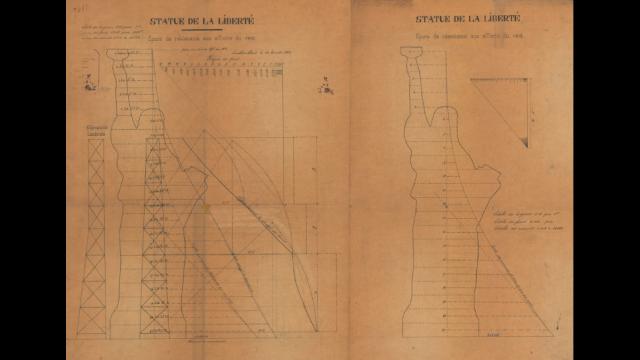Recently restored sketches of the Statue of Liberty suggest French engineer Gustave Eiffel, who was brought in to help with the project, had a different vision for the monument’s upraised arm.
In 1882, some six years into the construction of the Statue of Liberty, French sculptor Frédéric Auguste Bartholdi tweaked a design element proposed by Gustave Eiffel, changing the manner in which Lady Liberty holds her iconic torch, reports science writer Greg Miller in Smithsonian Magazine.
The statue was finally completed in 1884, so the adjustment happened “really late in the game,” New York University historian Edward Berenson told Smithsonian Mag.
The evidence for this revelation was found in a batch of forgotten documents belonging to Eiffel, for whom the famous wrought-iron lattice tower in Paris is named. Barry Ruderman, a collector of antique maps and drawings, acquired these documents at a Paris auction in 2018, some of which had to be restored by a conservator. In total, Ruderman, along with Alex Clausen, director of Ruderman’s gallery, identified 22 original drawings relating to the Statue of Liberty.
The contents included sheets filled with calculations, handwritten notes, lists of required hardware, and various design specifications, including specs for the iron truss that supports the statue, reports Smithsonian Mag.
“When we first realised what we had, we were awestruck,” Ruderman told Gizmodo. “While we understood the financial windfall of our good fortune, the immense historical significance of the discovery completely overshadowed everything else. The Statue of Liberty is quite possibly the most famous modern man-made object on the planet, and we were holding the engineering work that made its public display possible.”
Bartholdi designed the Statue of Liberty—a French gift to the United States—but Eiffel was recruited to help with some of the project’s trickier engineering aspects.
In particular, the statue had to withstand strong winds and the corrosive effects of salty ocean air. Eiffel, who had experience designing railway bridges, was well suited for the challenge, and he used this knowledge to design the statue’s support system. But as Berenson told Smithsonian Mag, it appears that Bartholdi made a last-minute adjustment to Eiffel’s plans:
Berenson thinks the drawings may nail down something that historians have long suspected but not been able to prove: that Bartholdi disregarded Eiffel’s engineering plans when it came to the statue’s upraised arm, electing to make it thinner and tilted outward for dramatic and aesthetic appeal. Several drawings appear to depict a bulkier shoulder and more vertical arm—a more structurally sound arrangement. But one of these sketches…was marked up by an unidentified hand with red ink that tilts the arm outward, as Bartholdi wanted. “This could be evidence for a change in the angle that we ended up with in the real Statue of Liberty,” Berenson says. “It looks like somebody is trying to figure out how to change the angle of the arm without wrecking the support.”
According to Berensen, Bartholdi was comfortable making such major adjustments, as Eiffel was “not totally hands-on,” he told Smithsonian Mag, adding that the statue is not as durable as it could have been.
“We knew that the discovery of the original drawings was likely to shed new light on existing historical questions related to the design and building of the Statue, but we weren’t exactly sure how,” Clausen told Gizmodo. “So to get the drawing in front of a scholar such as Edward Berenson and have him confirm that they indeed contain revelatory information that changes how we think about the Statue of Liberty, was really the icing on the cake.”
Looking ahead, Clausen and Ruderman are hoping to find a suitable institution to mount an exhibition of the drawings. Until then, the blueprints can be enjoyed at this digital museum.
